9 B2B Customer Experience Best Practices for 2025
June 25, 2025
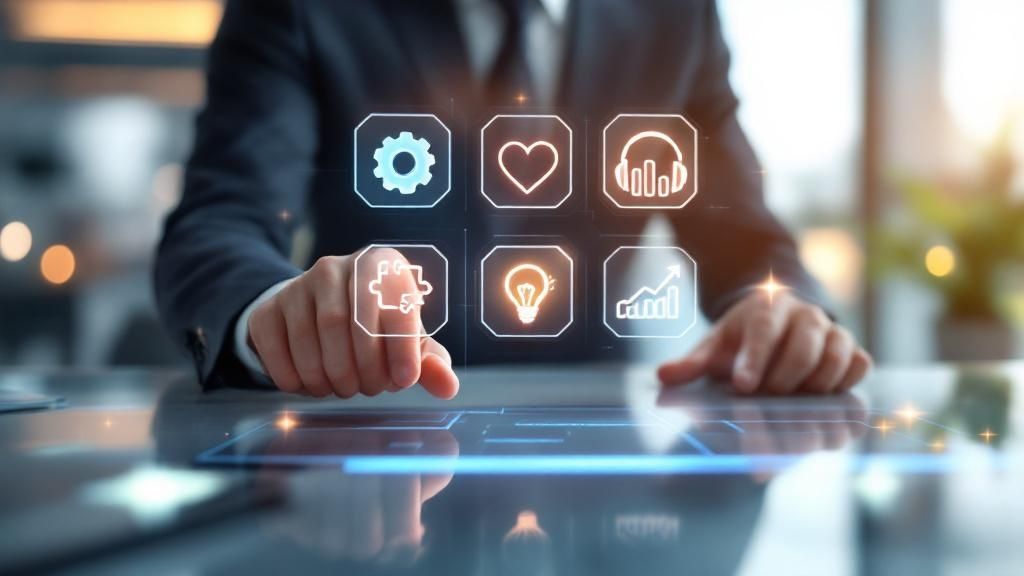
In a crowded B2B market, your product features and pricing tables are no longer the primary battlegrounds. The ultimate differentiator, the one that builds deep-rooted loyalty and fuels sustainable growth, is the quality of the customer experience you deliver. Every interaction, from the initial discovery call to a support ticket submitted years later, is an opportunity to strengthen or weaken that business relationship. For B2B founders and leaders, mastering this art isn't just a "nice-to-have"—it's a core business function that directly impacts retention, expansion revenue, and brand reputation.
This guide moves beyond vague platitudes and dives straight into actionable customer experience best practices tailored for the unique challenges of B2B technology companies. We've compiled a comprehensive list of strategies that will help you build a customer-first culture, turning passive users into passionate advocates for your brand. You won't find generic advice here. Instead, you'll get a detailed playbook covering everything from mapping the intricate customer journey to empowering your team to deliver exceptional service.
We will explore nine crucial pillars that support a world-class customer program:
- Deep Customer Understanding: Going beyond simple personas to map the entire journey.
- Omnichannel Consistency: Creating a unified experience across all touchpoints.
- Proactive Support: Solving problems before your customers know they exist.
- Meaningful Personalization: Tailoring interactions to specific business needs.
- Active Feedback Loops: Systematically listening and acting on customer input.
- Employee Empowerment: Recognizing that great CX starts with a great employee experience.
- Data-Informed Decisions: Using analytics to guide your experience strategy.
- Speed and Effectiveness: Responding to customer needs with urgency and precision.
- Continuous Improvement: Committing to an ongoing process of refinement.
Let's explore the methods that will help you create remarkable experiences, reduce churn, and accelerate your company's growth.
1. Master the B2B Customer Journey with Detailed Mapping
To deliver an exceptional customer experience, you must first understand the path your business customers travel. B2B customer journey mapping is the practice of creating a detailed visual story of every interaction a buying committee has with your company, from their first inkling of a problem to becoming a long-term advocate. This isn’t just about listing touchpoints; it’s a deep dive into your customer's world.
This powerful exercise reveals the emotions, motivations, and frustrations that define their experience. By visualizing this entire process, you uncover critical moments of truth where you can either forge a stronger connection or risk losing a valuable relationship. To truly master this, consider the principles of effective Customer Experience Design: Create Memorable Journeys to build interactions that are both functional and emotionally resonant.
Putting Journey Mapping into Action
Think beyond a simple flowchart. A great B2B journey map includes multiple layers of information for each stage:
- Customer Actions: What is the buying committee doing? (e.g., researching vendors, attending a demo, negotiating a contract).
- Emotional State: How are they feeling? (e.g., overwhelmed by options, excited by a feature, anxious about implementation).
- Pain Points & Questions: What challenges are they facing? What uncertainties do they have?
- Opportunities: Where can your team step in to add value, remove friction, or create a moment of delight?
For example, a journey map for a project management software company might reveal that during the "evaluation" stage, finance departments are often anxious about unforeseen costs. An opportunity would be to proactively create and share a transparent, all-inclusive pricing sheet, directly addressing their fears and building trust. This is a foundational step in crafting superior customer experience best practices that give you a durable competitive advantage.
Key Insight: The goal of journey mapping isn't just to see the journey, but to feel it. Empathy is your greatest tool for identifying where your experience falls short and where it can truly shine. For a more detailed guide, learn more about B2B customer journey mapping.
2. Unify the B2B Experience with Omnichannel Consistency
In today's B2B environment, buyers don't see channels; they see one company. Omnichannel consistency is the strategic commitment to delivering a unified, coherent experience across every touchpoint a customer has with your brand. This means the messaging, support quality, and user journey feel connected, whether a prospect is on your website, talking to a sales rep, using your mobile app, or engaging on social media.
This approach goes beyond just being present on multiple channels. It’s about creating an interconnected ecosystem where a conversation started on LinkedIn can be easily continued in a demo call without the customer having to repeat themselves. It ensures that the value proposition they read in a whitepaper is the same one your support team reinforces, building a powerful sense of reliability and trust.
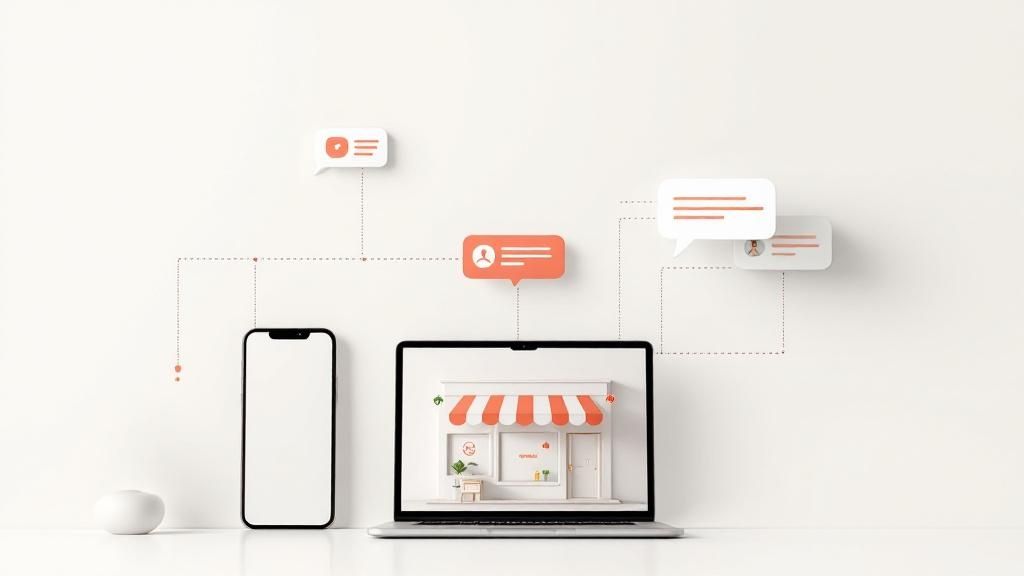
Putting Omnichannel Consistency into Action
A truly unified experience requires deep operational alignment, especially between marketing and sales. To make it a reality, focus on creating a single source of truth for all customer interactions:
- Integrated Customer Data: Create a unified customer profile that pulls data from your CRM, marketing automation platform, and support desk. This gives every team member a complete view of the customer's history.
- Consistent Team Training: Ensure every customer-facing employee, from sales development reps to implementation specialists, is trained on the same brand voice, product knowledge, and service standards.
- Regular Channel Audits: Periodically review all touchpoints from a customer's perspective. Does the pricing on your website match what the sales team is quoting? Is the tone in your emails consistent with your social media presence?
- Feedback-Driven Improvements: Use customer surveys and feedback to pinpoint where the experience feels disconnected. A customer might report a frustrating handoff between sales and support, revealing a gap you need to close.
For instance, a B2B technology company might find that leads generated from a webinar receive different follow-up messaging than those from a trade show. By standardizing the follow-up process and scripts in the CRM, they ensure every lead receives a consistent, high-quality experience, strengthening one of the core customer experience best practices.
Key Insight: Omnichannel isn't about being everywhere; it's about being one company everywhere. The goal is to make your internal departmental lines invisible to the customer, creating a single, fluid conversation that builds confidence at every step. To achieve this, it's crucial to understand the 5 Steps to Align B2B Marketing and Sales.
3. Proactive Customer Service and Support
Waiting for customers to report problems is a relic of the past. The new standard in exceptional service is to identify and solve issues before your customers are even aware of them. Proactive customer support is a forward-thinking philosophy where you use data and customer behavior analysis to anticipate needs, address potential frustrations, and offer solutions preemptively.

This approach shifts your support function from a reactive cost center to a proactive value driver. By getting ahead of problems, you not only prevent customer frustration but also demonstrate a deep, almost intuitive, understanding of their business needs. As championed by experts like Shep Hyken, this method builds powerful loyalty by showing you're invested in your customer's success, not just in closing their support tickets.
Putting Proactive Support into Action
Moving from reactive to proactive requires a strategic use of data and well-defined internal processes. The goal is to turn customer insights into timely, helpful interventions.
- Identify Problem Patterns: Analyze support tickets, usage data, and customer feedback to find recurring issues. If many users struggle after a new feature release, create and send a tutorial video to all users who haven't adopted it yet.
- Automate Alerts: Implement systems that automatically notify customers of potential disruptions. A B2B logistics platform could proactively alert a client that a specific shipping lane is experiencing delays, allowing them to reroute their inventory.
- Create Helpful Content: Develop a robust knowledge base, FAQ section, and video guides that address common questions. When a user navigates to a complex area of your software, a pop-up could offer a link to a relevant guide.
- Empower Your Team: Train your customer-facing teams to recognize early warning signs. A customer success manager might notice a dip in a client’s platform usage and reach out to offer a training refresher before the account becomes at-risk.
For example, a cybersecurity software company could monitor for new global threats and proactively send a security bulletin to all clients with specific instructions on how to configure their settings for protection. This turns a potential crisis into a moment of trust and reinforces the value of your service. This is one of the most impactful customer experience best practices for building unshakable customer confidence.
Key Insight: Proactive support changes the customer relationship from "call us when it's broken" to "we're always watching out for you." This foresight demonstrates a genuine partnership, which is the foundation of long-term B2B retention. For deeper reading, consider the methodologies from Zendesk on proactive engagement.
4. Personalization and Customization
In an era of endless digital noise, generic messaging falls flat. Personalization is the art of tailoring interactions, content, and services to the specific needs and context of each B2B customer. It moves beyond addressing someone by their first name in an email; it's about using data to deliver relevant experiences that make your customer feel seen, understood, and valued.
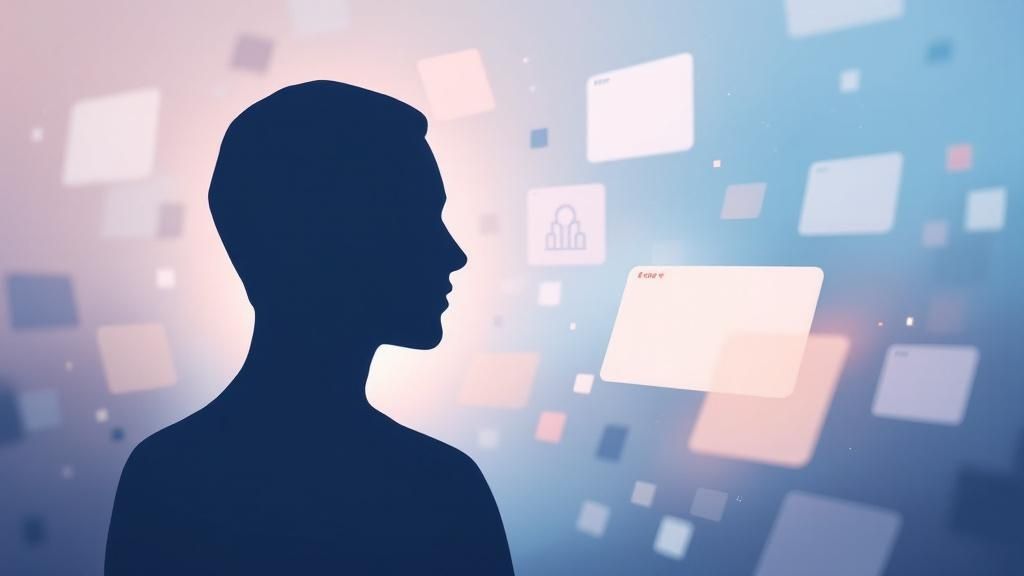
This practice uses customer data, behavioral insights, and even AI to create unique journeys. When a prospect from the manufacturing sector visits your website, they should see case studies relevant to their industry, not a generic gallery. This level of relevance builds immediate credibility and shows a deep understanding of their world, setting you apart from competitors who offer a one-size-fits-all approach.
Putting Personalization into Action
Effective personalization requires a thoughtful, data-driven strategy rather than guesswork. Build your approach by layering sophistication over time:
- Segment Your Audience: Start by grouping customers by firmographics like industry, company size, or geography. This is the foundation for delivering more relevant content.
- Use Behavioral Triggers: Automate communications based on actions. For instance, if a user repeatedly views your pricing page, trigger a follow-up from a sales rep with a custom quote.
- Gather Preferences Gradually: Employ progressive profiling in your forms. Instead of asking 20 questions upfront, gather new information with each interaction to build a rich customer profile over time.
- Test and Refine: Regularly review the performance of your personalization efforts. Are your tailored content recommendations increasing engagement? Adjust your algorithms and strategies based on what the data tells you.
For example, a marketing automation platform could personalize its in-app onboarding experience. Instead of a generic tour, it can ask a new user for their primary goal (e.g., lead generation, customer retention) and then highlight the specific features that will help them achieve that objective first. This is one of the most powerful customer experience best practices because it directly aligns your product's value with the customer's immediate goals. For more on creating tailored communications, explore these B2B email marketing best practices.
Key Insight: True personalization isn't about showing customers what you think they want to see; it's about helping them achieve their goals more efficiently. Focus on being relevant and helpful, and the feeling of a personal connection will follow.
5. Active Listening and Feedback Collection
The most successful B2B companies don’t just talk to their customers; they listen with intent. Active listening and systematic feedback collection are about creating a continuous dialogue, not just a one-time survey. It’s the practice of building channels to consistently gather, analyze, and, most importantly, act upon customer insights. This turns feedback from a simple data point into a strategic asset for growth and retention.
This process involves more than just sending out an annual Net Promoter Score (NPS) survey. It means embedding listening posts across the entire customer journey to capture sentiment in real-time. By systematically collecting and interpreting the voice of the customer, you can preemptively address issues, identify unmet needs, and discover opportunities for new product features, making it one of the most fundamental customer experience best practices.
Putting Feedback Collection into Action
Building a robust feedback program means making it easy for customers to share their thoughts and showing them their voice matters. A powerful feedback system integrates multiple methods to get a complete picture:
- Collection Channels: How are you gathering feedback? (e.g., in-app surveys, post-support ticket forms, quarterly business reviews, user interviews, social media monitoring).
- Analysis & Synthesis: How are you making sense of the data? (e.g., tagging qualitative feedback by theme, tracking quantitative scores over time, sharing insights in cross-departmental meetings).
- Action & Communication: What are you doing with the insights? How are you closing the loop? (e.g., creating a product roadmap item, training a support agent, launching a "you asked, we delivered" email campaign).
- Ownership: Who is responsible for each part of the feedback loop? (e.g., product team for feature requests, success team for service issues).
For instance, Slack is a prime example of a company that integrates user feedback directly into its development cycle. They actively monitor user forums, social media, and direct support channels, turning user suggestions and complaints into tangible product improvements. This creates a virtuous cycle where customers feel heard and invested, knowing their input directly shapes the tool they rely on daily.
Key Insight: Collecting feedback is only half the battle. The real impact comes from closing the loop and showing your customers that their input drives meaningful change. This transparency builds immense trust and loyalty.
6. Employee Experience and Empowerment
The most powerful, yet often overlooked, driver of exceptional customer experience originates from within your own walls. The principle is simple yet profound: the quality of your employee experience (EX) directly dictates the quality of your customer experience (CX). When your team members feel valued, engaged, and empowered, they become passionate ambassadors for your brand, translating their positive energy into authentic and helpful customer interactions.
This isn't about office perks; it's about creating a culture where employees are equipped and motivated to solve customer problems. An empowered employee doesn't need to escalate every minor issue or stick rigidly to a script. They have the autonomy and confidence to make decisions that serve the customer's best interest, creating moments of genuine connection. This internal health is a core pillar of building sustainable customer experience best practices that customers can feel.
Putting Employee Empowerment into Action
Building this culture requires more than just a mission statement. It involves deliberate structural and cultural changes:
- Empowerment with Guardrails: Grant your customer-facing teams the authority to resolve issues on the spot. Ritz-Carlton famously gives employees a discretionary budget of up to $2,000 to solve a guest's problem without seeking approval.
- Hire for Attitude: Prioritize hiring individuals who align with your company’s values and have a natural service-oriented mindset. You can train for specific skills, but it's much harder to train for empathy and a positive attitude.
- Invest in Continuous Training: Equip your team not just with product knowledge but also with communication and problem-solving skills.
- Share Success Stories: Internally celebrate and share stories of employees going above and beyond for customers. This reinforces desired behaviors and motivates the entire team.
For a B2B software company, this could mean empowering a support agent to issue a one-month credit to a frustrated user experiencing a critical bug, without needing three levels of management approval. This quick, decisive action turns a potential detractor into a loyal advocate, proving that a focus on your team is the most direct path to customer delight.
Key Insight: Your employees are the living embodiment of your brand. Investing in their training, well-being, and empowerment isn't a cost center; it's the most fundamental investment you can make in your customer relationships.
7. Embrace Data-Driven Decision Making
To truly elevate your customer experience, you must move beyond intuition and anchor your strategy in hard evidence. Data-driven decision making is the practice of using customer data, analytics, and key metrics to guide every improvement and business choice. This approach replaces assumptions with empirical proof, allowing you to understand and predict customer behavior with remarkable accuracy.
This methodology is about more than just collecting numbers; it's about translating raw data into a clear story about your customers' needs and preferences. By methodically measuring behavior, satisfaction, and outcomes, you can identify hidden trends and opportunities to improve interactions. Companies like Amazon have built empires on this principle, using customer analytics to personalize recommendations and refine their entire service delivery model. This commitment to data is a cornerstone of modern customer experience best practices.
Putting Data-Driven Decisions into Action
A successful data-first culture requires a structured approach to gathering and applying insights. Instead of getting lost in endless spreadsheets, focus on a system that delivers clarity:
- Start with Questions: Before you collect any data, define what you need to know. For instance, "Where in our onboarding process do new users drop off most frequently?" or "Which support topics correlate with the highest churn risk?"
- Combine Data Types: Blend quantitative data (e.g., usage metrics, support ticket volume) with qualitative insights (e.g., survey responses, customer interviews). This combination provides both the "what" and the "why" behind customer actions.
- Ensure Data Integrity: Your insights are only as good as your data. Establish consistent processes for data collection and cleaning across all platforms to ensure accuracy and reliability.
- Empower Your Teams: Provide your customer-facing teams with accessible dashboards and the training needed to interpret data. This enables them to make informed, real-time decisions that directly benefit the customer.
For example, a B2B software company might notice from usage analytics that a powerful new feature is being ignored. By combining this with qualitative feedback, they could discover the feature's user interface is confusing. Armed with this specific insight, they can redesign the interface, address the root cause of the problem, and deliver more value to their customers.
Key Insight: Data doesn't just tell you what happened; it illuminates the path forward. Using analytics to guide your actions turns your customer experience from a series of guesses into a predictable engine for growth and loyalty. To build a robust framework, explore these principles for a data-driven marketing strategy.
8. Rapid Response and Resolution
In the B2B world, a customer's problem is your problem, and the speed at which you solve it directly impacts their loyalty and trust. Rapid response and resolution is a customer support philosophy centered on minimizing wait times and resolving issues effectively on the first contact. It’s about treating every support ticket not as an interruption, but as a critical opportunity to prove your value and commitment to your customer's success.
This approach goes beyond just being fast; it’s about being both fast and right. A quick but incorrect answer only creates more frustration. By focusing on both speed and accuracy, you show respect for your customer's time and operational needs. This commitment to swift, effective support is a cornerstone of modern customer experience best practices and can become a powerful differentiator in a crowded market.
Putting Rapid Resolution into Action
Building a responsive support system requires a strategic combination of people, processes, and technology. Your goal is to eliminate friction and empower your teams to deliver immediate value.
- Tiered Support: Implement a structured support system where simple, common issues are handled by frontline agents or automation, while complex technical problems are escalated to specialized experts. This ensures the right level of expertise is applied efficiently.
- Empowered Frontline Staff: Give your support agents the authority and tools to make decisions and solve problems without needing multiple approvals. This autonomy, seen in legendary service from companies like Zappos, dramatically improves first-contact resolution.
- Comprehensive Knowledge Base: Develop and maintain a detailed internal and external knowledge base. This equips your team with instant answers and allows customers to find solutions themselves, reducing ticket volume.
- AI and Chatbots: Use AI-powered chatbots for instant initial responses, gathering essential information, and handling routine queries 24/7. This frees up human agents to focus on high-impact, complex resolutions.
For instance, a B2B financial analytics platform could use a chatbot to instantly guide a user on how to generate a standard report. However, if the user reports a data discrepancy, the chat could intelligently escalate the ticket to a Tier 2 data specialist who has the authority to investigate and resolve the issue directly, turning a potential crisis into a confidence-building interaction.
Key Insight: Speed without resolution is meaningless. The ultimate goal is not just to close a ticket quickly, but to solve the customer's underlying problem completely. Make first-contact resolution your primary metric of success to build a truly exceptional support experience.
9. Continuous Improvement and Innovation
Exceptional customer experience isn't a destination you arrive at; it's a discipline you practice every day. A commitment to continuous improvement means treating your customer experience strategy as a living entity that must adapt and evolve. This involves regularly evaluating your initiatives, absorbing new customer feedback, and actively seeking out fresh ways to create value based on changing market conditions and emerging technologies.
This proactive approach prevents your experience from becoming stagnant. It’s the difference between a company that reacts to problems and one that anticipates needs, consistently delighting customers by getting better over time. Drawing from principles like Toyota's Kaizen philosophy, this practice embeds a culture of constant refinement into your team's DNA, ensuring your service quality is always on an upward trajectory.
Putting Continuous Improvement into Action
Building this into your operations requires structure and a forward-thinking mindset. It’s about creating systems that encourage and reward incremental and breakthrough enhancements.
- Establish Review Cycles: Set up quarterly or bi-annual reviews of all customer experience programs. Use data to assess what's working and what's not.
- Create Innovation Sandboxes: Dedicate resources to a "sandbox" environment where your team can test new experience concepts without risk to your live customer base.
- Encourage Idea Generation: Implement a formal process for employees, especially those on the front lines, to submit suggestions for improving customer interactions.
- Balance and Prioritize: Not every new idea is a good one. Balance the pursuit of new enhancements with the need to maintain and perfect the practices that are already proven to work.
For instance, a B2B software company might notice from support tickets that users are consistently confused about a specific feature. Instead of just updating the FAQ, a continuous improvement approach would involve redesigning the feature's user interface, creating a new in-app tutorial, and A/B testing the changes to confirm they resolved the core confusion. This is a core component of building enduring customer experience best practices.
Key Insight: The greatest threat to a good customer experience is complacency. By embedding continuous improvement into your culture, you turn your entire organization into an engine for enhancing customer value. To do this effectively, you must understand how to measure marketing success for data-driven B2B growth, as this provides the baseline for what needs improving.
Customer Experience Best Practices Comparison
Turning Best Practices into Your Competitive Advantage
We’ve journeyed through nine fundamental pillars of modern B2B customer experience. From the granular detail of customer journey mapping to the broad impact of empowering your employees, each practice represents a critical opportunity to build something truly special. It's easy to look at a comprehensive list like this and feel overwhelmed, seeing a mountain of tasks rather than a roadmap to success. But the goal isn’t to implement everything overnight. The goal is to begin.
The most successful B2B software companies don't just "do" customer experience; they live it. It’s a cultural mindset that permeates every department, from engineering to sales, and every decision, from product updates to hiring. The customer experience best practices we've detailed are not just a checklist to be completed. They are the very ingredients for building a durable, resilient business that stands apart in a crowded marketplace.
Think of it this way: your product can be copied, your pricing can be matched, but an exceptional customer experience is incredibly difficult to replicate. It's a competitive advantage built from hundreds of small, intentional actions that accumulate over time. When you proactively solve a problem before a customer even reports it, or when you use feedback to build a feature they desperately need, you are forging a bond that goes far beyond a simple transactional relationship. You are building loyalty, trust, and advocacy.
Your First Steps Toward Mastery
The journey to an exceptional customer experience is a marathon, not a sprint. The key is to start with focused, intentional action. Don't try to boil the ocean. Instead, select one or two areas from this guide where you can make a significant, near-term impact.
Here's a simple framework to get started:
- Assess Your Current State: Where are the biggest gaps? Use the principles of Active Listening and Feedback Collection to find out. Send a survey, conduct a few customer interviews, or analyze your support tickets to identify the most common points of friction.
- Pick Your Battles: Based on your assessment, choose a focus area. Is your response time lagging? Make Rapid Response and Resolution your top priority for the next quarter. Are customers complaining about a disjointed experience across different platforms? It's time to focus on creating Omnichannel Experience Consistency.
- Define a Small, Measurable Project: Break your chosen practice down into a concrete project. For instance, if you choose Personalization, a starting project could be to simply add the customer's company name and a recent success metric to your monthly check-in emails. It’s a small change that shows you are paying attention.
- Execute, Measure, and Repeat: Implement your project and track the results. Did it improve a key metric like customer satisfaction (CSAT) or reduce support ticket volume? Use these learnings to refine your approach and then move on to the next challenge.
This iterative process of continuous improvement is the engine of customer-centric growth. Each small win builds momentum and reinforces a culture that places the customer at the heart of your operation. By consistently applying these customer experience best practices, you aren't just improving service; you are building a powerful growth engine fueled by happy, successful customers who become your most effective marketers. Your commitment to their success will ultimately define your own.
At Big Moves Marketing, we specialize in helping B2B SaaS companies embed these customer-centric principles directly into their growth strategies. If you’re ready to turn your customer experience into a measurable competitive advantage, our fractional CMO services provide the strategic direction and hands-on execution to make it happen. Visit us at Big Moves Marketing to learn how we can help you build deeper customer relationships that drive retention and revenue.
%20-%20Alternate.svg)
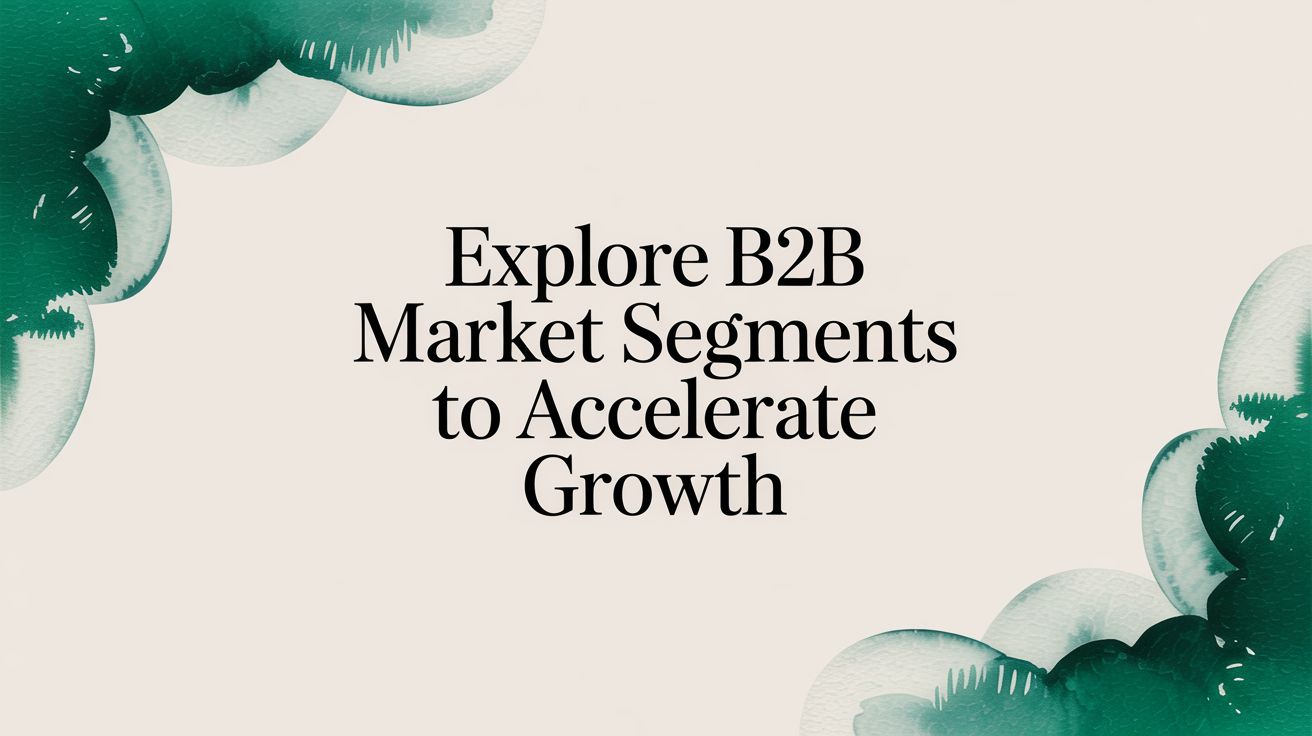
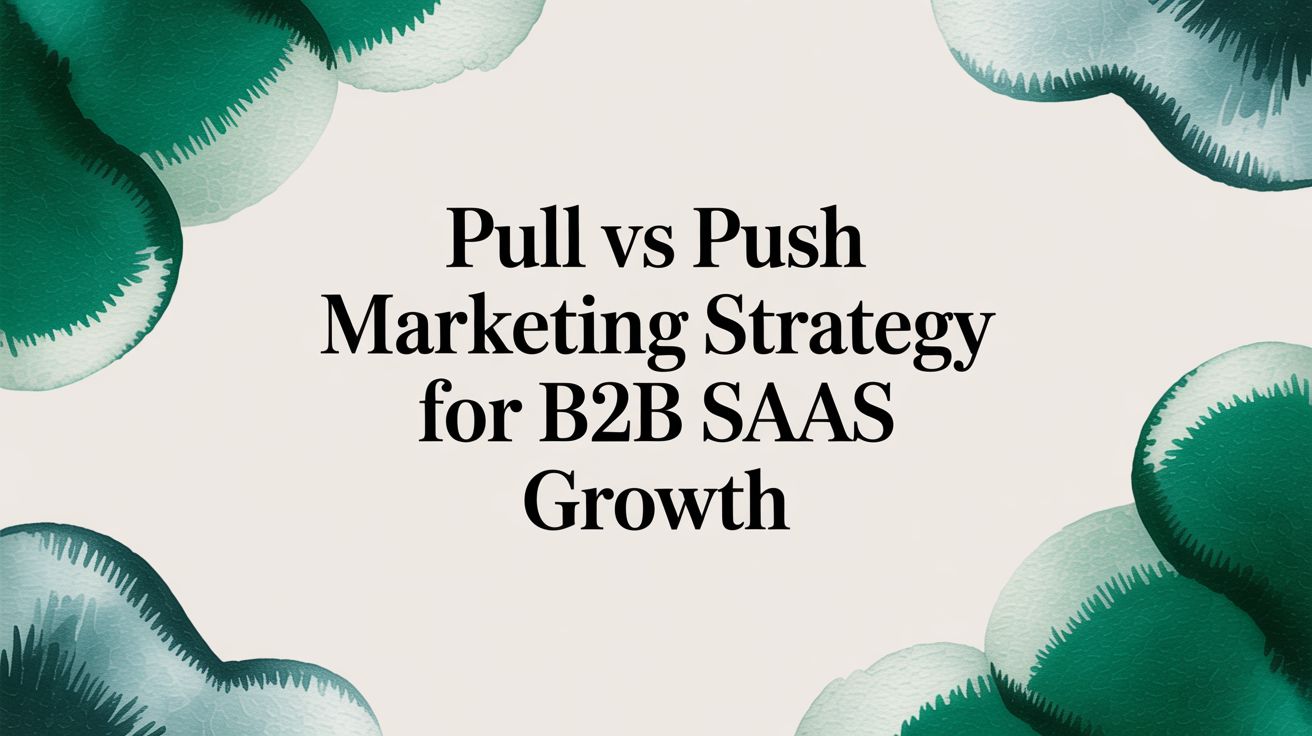
%20-%20white.svg)